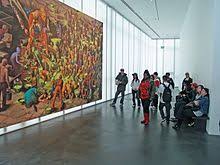TALKS ON THE ISLANDS OF ART (part 1)
 Traveling in the endless sea of the Internet, you can find a great many large and small sites where people share their art, want to be heard and seen, but more often want to sell their works. On one of these islands I was lucky enough to meet a man who is seriously interested in the future of art. This is a Spanish writer and artist, recently engaged in the art associated with the latest computer technology Jrn Calo. He leads his multimedia magazine.
Traveling in the endless sea of the Internet, you can find a great many large and small sites where people share their art, want to be heard and seen, but more often want to sell their works. On one of these islands I was lucky enough to meet a man who is seriously interested in the future of art. This is a Spanish writer and artist, recently engaged in the art associated with the latest computer technology Jrn Calo. He leads his multimedia magazine.
We started a correspondence, which turned out to be interesting and useful to both of us. Questions related to contemporary art, concern many. Therefore, we decided to make our dialogue accessible to others – on the pages of the Spanish magazine and here on our website.
After my question, does he like the abstract works of one contemporary artist, Jrn Calo wrote me the following.02/12/2011 Jrn Calo:
Hello Tatiana!
I read the classics of Russian literature when I was young. My favorite writers are Alexander Solzhenitsyn and Fedor Dostoevsky, although I have read others. Painting without literature is nothing. It should show the world, the mode of existence and vision, should have depth, mystery, should captivate, mesmerize the viewer. A painting should not be like other works, it should be unique. If the work is predictable, it does not exist as such, it will not survive in the vast ocean of art.
I am glad that you liked my magazine. We live in the XXI century and, in my opinion, in the future, everything that is written in oil or acrylic can not be better than the great masters of the XX century. Artists today must create new worlds that correspond to the time in which we live, must talk about their century, the century of computers, and use digital technology tools: Software Design: 2D, 3D, fractals, algorithmic art, video art, installations, hypertext , Net art, etc.
Writing or creating as in the 19th or 20th century no longer makes sense. No matter how many people try, they cannot surpass Vincent van Gogh, Gauguin, Picasso, Dali and other teachers who went down in the history of art.
Best wishes. We are just a click away.
Jrn calo
02/13/2011 Tatyana Nesvetaylo writes:
Hello Jrn!
Repeatedly predicted the death of painting, beginning in the mid-19th century, when photography spread. But this only helped the painting gain freedom from literature and didactics. After the advent of the cinema, the theater was predicted to die, and it gives birth to ever new forms, using also new technologies. E-books are replacing paper. Perhaps in the future paper books will become an inadmissible luxury, as well as natural food products.
In digital art, man is becoming less and less, so the need for a word reappeared in order to spiritualize new digital worlds. I think that the free movement of the human hand, which is the vehicle of human feelings and thoughts, will not be completely replaced by high-tech art. Of course, it will be much less, but the more valuable it will be. Just as any reproduction of music or the creation of music by digital means will not crowd out a live musician.
I agree that it is necessary to change thinking, look for new forms. And you are absolutely right that you cannot do without new technologies here. But do not replace one with another. These are parallel interpenetrating paths.
Following your logic, should Solzhenitsyn not take up a pen after Dostoevsky, Tolstoy, Turgenev?
Best wishes
Tatyana




